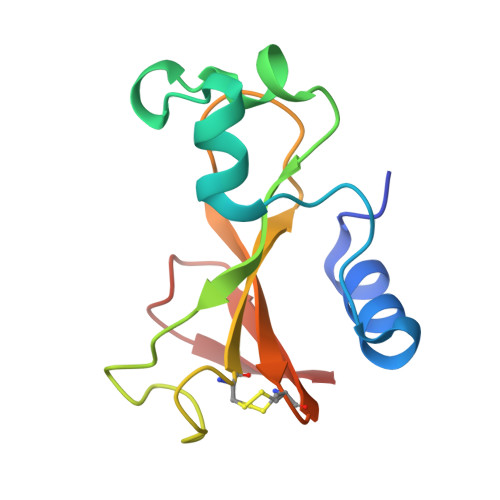Disulfide mutants of barnase. I: Changes in stability and structure assessed by biophysical methods and X-ray crystallography.
Clarke, J., Henrick, K., Fersht, A.R.(1995) J Mol Biology 253: 493-504
- PubMed: 7473729
- DOI: https://doi.org/10.1006/jmbi.1995.0568
- Primary Citation of Related Structures:
1BNE, 1BNF, 1BNG - PubMed Abstract:
In this series of papers, we examine the effects of introducing disulfide bonds on the properties, structure and thermodynamics of a small globular protein, barnase. Three mutants have been made, in each of which a single crosslink confers different properties. Two of the disulfide bonds, between residues 43 and 80 (43-80) and between residues 85 and 102 (85-102), stabilise the protein, relative to both wild-type and the corresponding (reduced) dithiol forms: 85-102 is more stable than predicted from the entropic destabilisation of the unfolded state; 43-80 is less stable than predicted. The third disulfide bond, between residues 70 and 92 (70-92) destabilises the protein relative to both wild-type and the corresponding dithiol form, implying significant disruption of the folded protein on formation of the disulfide bond. Crystal structures of the three mutant proteins have been solved. All three proteins have essentially the same fold as wild-type, but with left-handed disulfide bonds, which have dihedral geometries that have not been observed in naturally occurring disulfides. In the very stable mutant 85-102, there is no significant difference between the mutant and wild-type structures: these data do not explain the large stability of this protein. The disulfide bond at 43-80 induces small structural rearrangements close to the site of the disulfide bond, associated with some local disorder: the crosslink appears to decrease the stability of the native form of the protein. The destabilising disulfide bond at 70-92 induces considerable structural change, with displacement of a loop and consequent disruption of a stabilising salt-bridge. Our studies do not support the view that the conformation of the disulfide bond is crucial in determining the stability of the mutant proteins.
- Centre for Protein Engineering, MRC Centre, Cambridge, UK.
Organizational Affiliation:
















